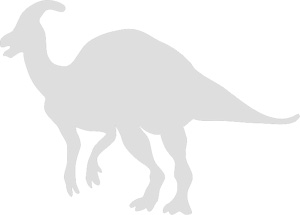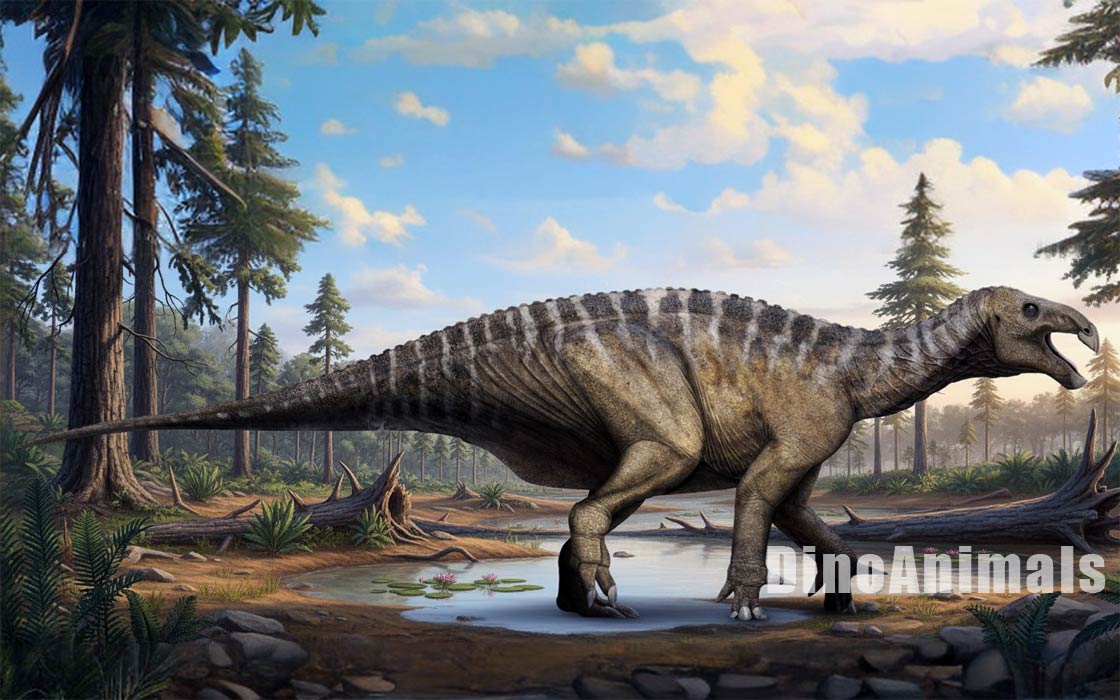Every month, 100,000 readers use the Dinosaur Database, but we receive no support from you. Developing and updating the database requires a lot of work. If you want it to remain open and be updated, please support us via the "Buy us a coffee" button available on every page or via the Support page.
Dinosaur: Iguanodon bernissartensis

| Length*: | 12.6 m | 41.3 ft |
| Weight*: | 9.1 t | 20,062 lb |
*The largest known specimen
Period
Epoch: Early Cretaceous
Stage: Barremian-Aptian
Years: 125.8-119.5 Ma
Details
Status: valid
Author: Boulenger
Year: 1881
Distribution
Area: Europe
Country: Belgium, United Kingdom, Spain, Germany, France
Region: Hainaut, England, Valencian Community, North Rhine-Westphalia, Grand Est
Formation: Sainte-Barbe Clays, Argiles à Plicatules, Argiles Ostréennes, Grès et sables piquetés, Capas Rojas, Arcillas de Morella, Wealden Group, Wessex
Description
Iguanodon bernissartensis
Iguanodon bernissartensis is one of the best-known and earliest-discovered dinosaurs, famous for its distinctive thumb spikes and pivotal role in the history of paleontology. This large herbivorous dinosaur lived during the Early Cretaceous period, around 126–119 million years ago, in what is now Europe. The name Iguanodon means “iguana tooth,” reflecting the resemblance of its teeth to those of modern iguanas, while “bernissartensis” refers to the town of Bernissart in Belgium, where numerous specimens were first unearthed. Belonging to the group Ornithopoda, Iguanodon represents a key genus that illustrates the evolutionary transition from small, bipedal ancestors to larger, more complex herbivorous dinosaurs.
Physical Characteristics
Iguanodon bernissartensis was a large ornithopod, reaching lengths of up to 13 meters (43 feet) and weights up to 9 metric tons. It had a robust, semi-quadrupedal build with powerful hind legs and slightly shorter, muscular forelimbs, allowing it to move both on two and four legs. One of its most distinctive features was the large, conical thumb spike on each hand, which likely served as a defensive weapon against predators or possibly for foraging purposes. The thumb spikes could reach lengths of up to 15 centimeters (6 inches). The hand also had three middle digits ending in hoof-like claws, which were used for support while walking, and a flexible fifth finger that could grasp objects, suggesting a degree of dexterity.
The skull of Iguanodon was elongated and equipped with a large, beak-like structure at the front of its jaws, ideal for cropping vegetation. Behind the beak were rows of teeth suited for grinding plant material, forming a dental battery that could replace worn teeth throughout the dinosaur’s life. Its tail was long and stiff, supported by ossified tendons, which provided balance and stability, particularly while running. The posture of Iguanodon is thought to have been semi-erect, and it could shift between a bipedal stance, likely for faster locomotion, and a quadrupedal stance for feeding and foraging.
Diet and Feeding Habits
Iguanodon bernissartensis was a herbivore that fed on a wide variety of plant materials available in its environment. Its beak-like snout and chisel-shaped teeth suggest it could efficiently process tough, fibrous plants such as ferns, cycads, and conifers. The structure of its jaws allowed for a grinding motion, which helped to break down vegetation before swallowing, a rare adaptation among early herbivorous dinosaurs. The flexible fifth digit may have been used to manipulate branches or gather food, while the thumb spikes could have been employed to defend against predators or perhaps to strip bark or foliage from trees. The presence of a large gut cavity suggests that Iguanodon had an extensive digestive system capable of fermenting tough plant materials, similar to modern herbivorous mammals.
Habitat and Distribution
Fossils of Iguanodon bernissartensis have been found across Europe, particularly in Belgium, England, and Spain, indicating that it was widely distributed across the continent during the Early Cretaceous period. The environments it inhabited ranged from coastal plains to river valleys and floodplains, with a climate that was generally warm and humid. These areas were characterized by lush vegetation, including ferns, horsetails, and gymnosperms, providing abundant food sources for large herbivores like Iguanodon. Sedimentological evidence suggests that these habitats included a mix of open woodland and more densely vegetated areas, where Iguanodon could graze on low-lying plants or browse on taller vegetation. Its ability to switch between bipedal and quadrupedal locomotion would have allowed it to exploit a wide range of plant resources within these environments.
Behavior and Social Structure
Evidence suggests that Iguanodon bernissartensis may have been a social dinosaur, living in herds as a defense mechanism against predators. The discovery of multiple individuals preserved together in the Bernissart coal mines in Belgium suggests that these dinosaurs may have traveled in groups, possibly moving across landscapes in search of food and water or for protection against large theropods. Herd behavior would have also facilitated care for young and provided collective vigilance against predators. The structure of its limbs indicates that it could move relatively quickly on two legs, possibly to escape danger, while normally feeding and foraging on all fours. The large thumb spikes, while possibly used in defense, may also have played a role in social displays or competition among individuals, such as during mating rituals or territorial disputes.
Discovery and Research
Iguanodon bernissartensis was first discovered in 1822 by Gideon Mantell in England, based on fossil teeth that resembled those of modern iguanas. However, it wasn’t until the discovery of nearly 30 complete skeletons in a coal mine at Bernissart, Belgium, in 1878 that Iguanodon became one of the first dinosaurs to be reconstructed. These discoveries, led by Louis Dollo, provided significant insights into the anatomy, posture, and potential behavior of Iguanodon, making it one of the most well-understood dinosaurs of its time. The extensive remains allowed scientists to study various aspects of its anatomy, including the famous thumb spikes, and led to an understanding of its ability to move both bipedally and quadrupedally. Subsequent finds throughout Europe and in other parts of the world have confirmed its wide distribution and ecological importance during the Early Cretaceous period.
Significance and Interesting Facts
Iguanodon bernissartensis is significant for its role in the early history of dinosaur paleontology and as one of the first dinosaurs to be named and understood as a distinct group of ancient reptiles. The discovery of Iguanodon helped establish the concept of dinosaurs as a group of extinct, prehistoric reptiles, distinct from modern lizards and other living reptiles. The distinctive thumb spikes and other features of Iguanodon have made it a key species for understanding the evolution of ornithopods and the diversity of dinosaur herbivores during the Early Cretaceous. The genus illustrates an important evolutionary stage between smaller, more primitive herbivorous dinosaurs and the later, more specialized forms that dominated the Cretaceous period. Its social behavior, adaptability, and widespread distribution make Iguanodon a pivotal species in the study of dinosaur ecology and evolution.
Locations
Sources
Material: At least several dozen individuals (include almost complete skeletons and skulls).
References: Verdú, F. J., Royo-Torres, R., Cobos, A., & Alcalá, L. (2015). Perinates of a new species of Iguanodon (Ornithischia: Ornithopoda) from the lower Barremian of Galve (Teruel, Spain).Norman, D.B., (2012). Iguanodontian taxa (Dinosauria: Ornithischia) from the lower cretaceous of England and Belgium. In: Godefroit, P. (Ed.), Bernissart Dinosaurs and Early Cretaceous Terrestrial Ecosystems.Paul, G.S. (2008) "A revised taxonomy of the iguanodont dinosaur genera and species".Gasulla, J.M., Escaso, F., Ortega, F., Sanz, J.L., (2014). New hadrosauriform cranial remains from the Arcillas de Morella Formation (lower Aptian) of Morella, Spain.Norman, D.B. (2010) "A taxonomy of iguanodontian (Dinosauria: Ornithopoda) from the lower Wealden Group (Cretaceous: Valanginian) of southern England".Norman, D.B., (1987). A mass-accumulation of vertebrates from the lower cretaceous of Nehden (Sauerland), West Germany.




